Evaluation of Accounting Standards for Emission Allowances: A Report
VerifiedAdded on 2020/04/01
|15
|2666
|37
Report
AI Summary
This report provides a comprehensive evaluation of accounting standards and methods used for emission allowances. It addresses the absence of universally accepted standards and explores different accounting models, such as the intangible asset and inventory models, used to account for emission credits. The report includes examples of journal entries for emission allowances, illustrating how these transactions are recorded under various methods, including IAS38 and the revaluation model. It also examines the consequences of emission allowances on financial statements, including the balance sheet, income statement, and cash flow statement. The report highlights the impact on assets, liabilities, and income recognition, offering a detailed analysis of this increasingly important area of financial accounting. It concludes by summarizing the key findings and emphasizing the implications of emission allowances on environmental sustainability and financial reporting practices.

Name of student:
Registration number:
Unit Title:
Unit code:
Name of supervisor:
Date due:
Registration number:
Unit Title:
Unit code:
Name of supervisor:
Date due:
Paraphrase This Document
Need a fresh take? Get an instant paraphrase of this document with our AI Paraphraser
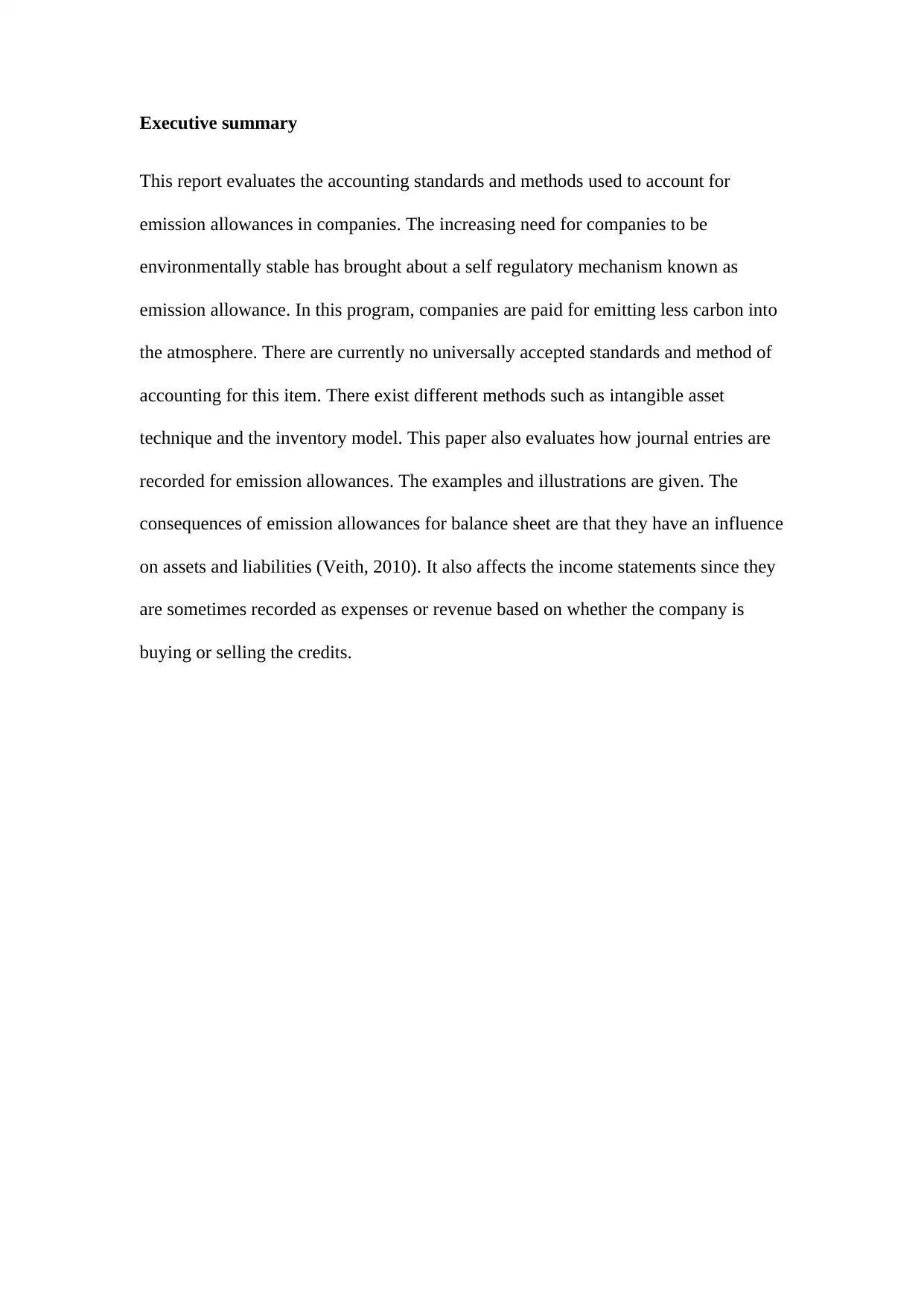
Executive summary
This report evaluates the accounting standards and methods used to account for
emission allowances in companies. The increasing need for companies to be
environmentally stable has brought about a self regulatory mechanism known as
emission allowance. In this program, companies are paid for emitting less carbon into
the atmosphere. There are currently no universally accepted standards and method of
accounting for this item. There exist different methods such as intangible asset
technique and the inventory model. This paper also evaluates how journal entries are
recorded for emission allowances. The examples and illustrations are given. The
consequences of emission allowances for balance sheet are that they have an influence
on assets and liabilities (Veith, 2010). It also affects the income statements since they
are sometimes recorded as expenses or revenue based on whether the company is
buying or selling the credits.
This report evaluates the accounting standards and methods used to account for
emission allowances in companies. The increasing need for companies to be
environmentally stable has brought about a self regulatory mechanism known as
emission allowance. In this program, companies are paid for emitting less carbon into
the atmosphere. There are currently no universally accepted standards and method of
accounting for this item. There exist different methods such as intangible asset
technique and the inventory model. This paper also evaluates how journal entries are
recorded for emission allowances. The examples and illustrations are given. The
consequences of emission allowances for balance sheet are that they have an influence
on assets and liabilities (Veith, 2010). It also affects the income statements since they
are sometimes recorded as expenses or revenue based on whether the company is
buying or selling the credits.
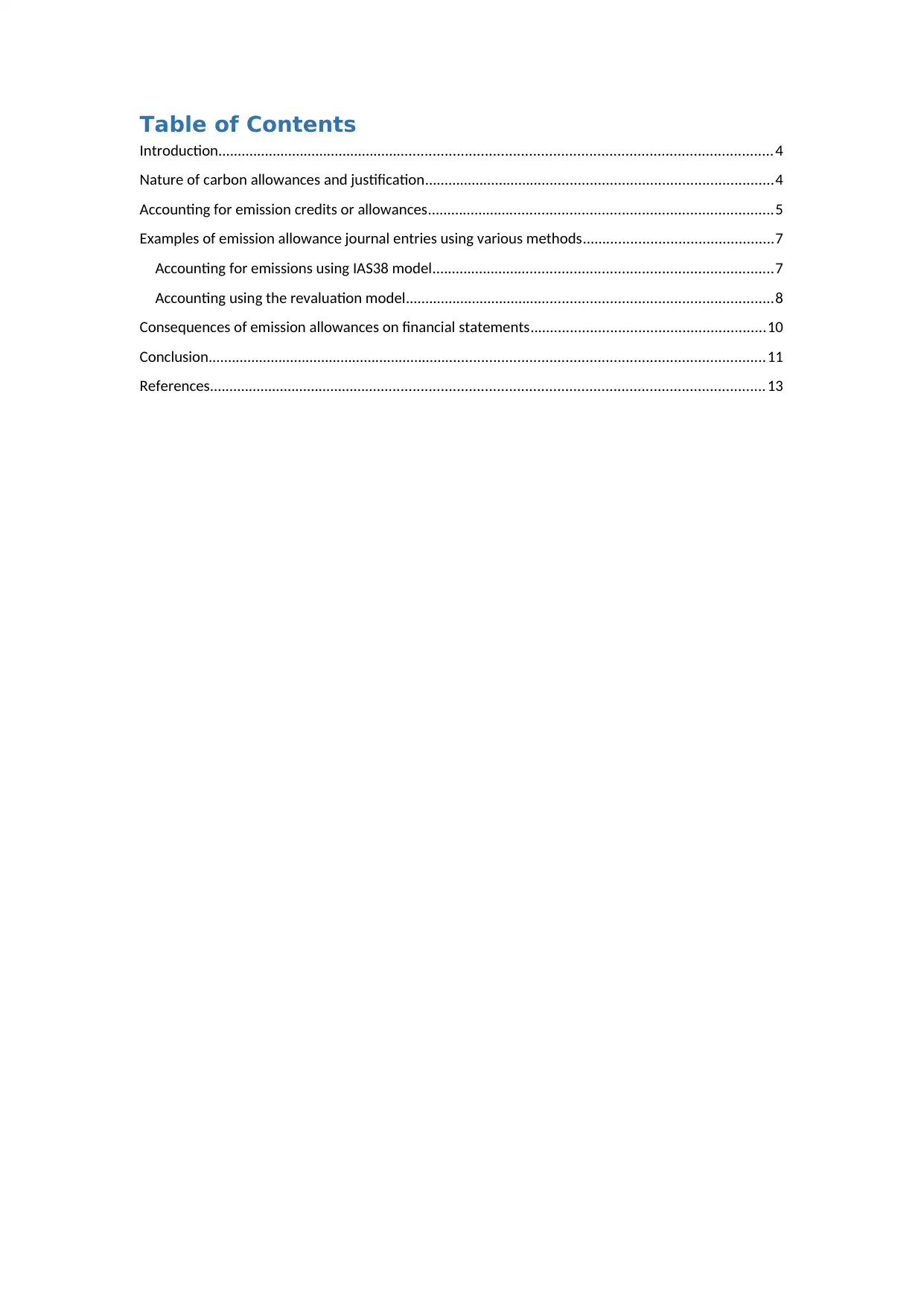
Table of Contents
Introduction............................................................................................................................................4
Nature of carbon allowances and justification........................................................................................4
Accounting for emission credits or allowances.......................................................................................5
Examples of emission allowance journal entries using various methods................................................7
Accounting for emissions using IAS38 model......................................................................................7
Accounting using the revaluation model.............................................................................................8
Consequences of emission allowances on financial statements...........................................................10
Conclusion.............................................................................................................................................11
References............................................................................................................................................ 13
Introduction............................................................................................................................................4
Nature of carbon allowances and justification........................................................................................4
Accounting for emission credits or allowances.......................................................................................5
Examples of emission allowance journal entries using various methods................................................7
Accounting for emissions using IAS38 model......................................................................................7
Accounting using the revaluation model.............................................................................................8
Consequences of emission allowances on financial statements...........................................................10
Conclusion.............................................................................................................................................11
References............................................................................................................................................ 13
⊘ This is a preview!⊘
Do you want full access?
Subscribe today to unlock all pages.

Trusted by 1+ million students worldwide
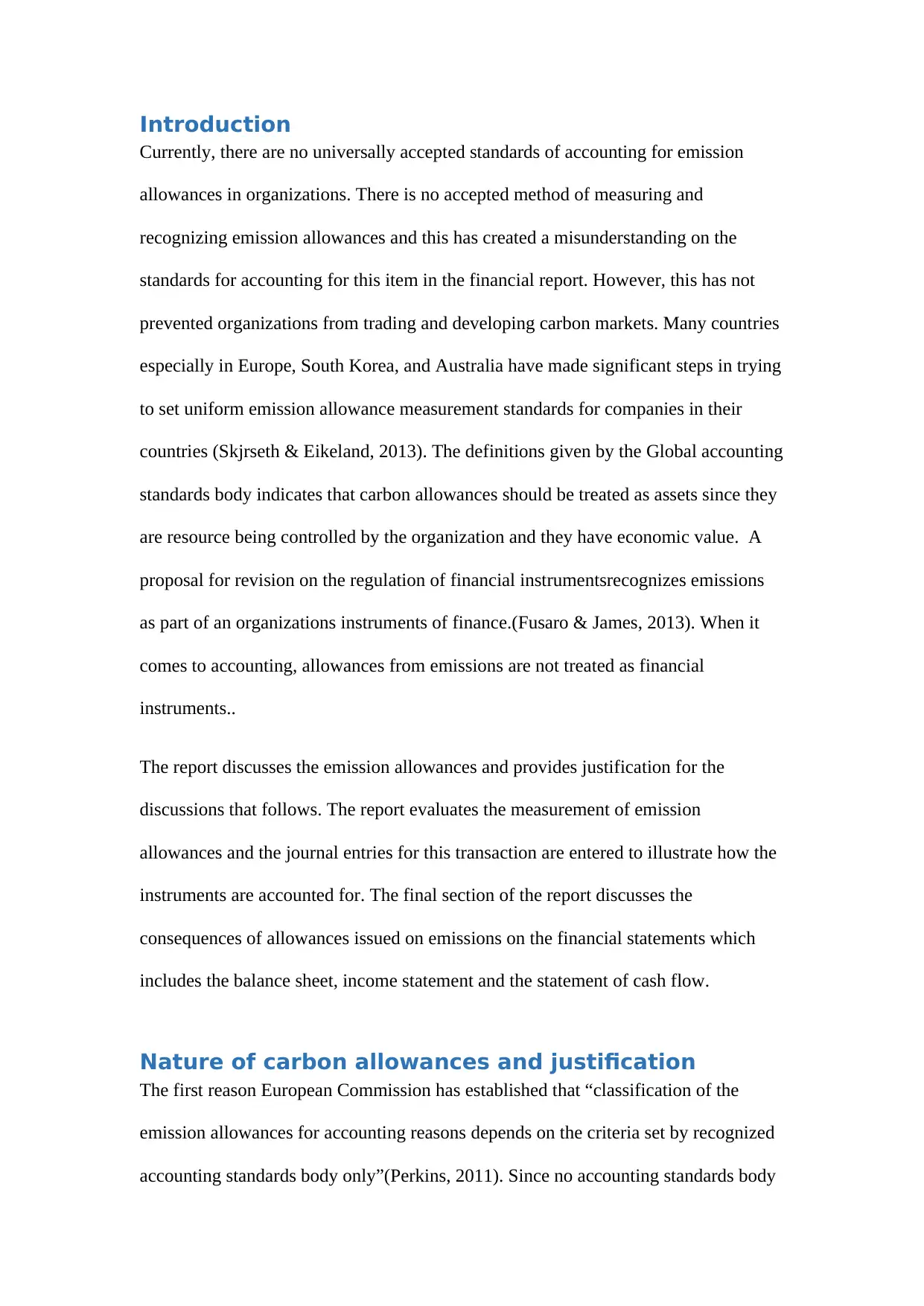
Introduction
Currently, there are no universally accepted standards of accounting for emission
allowances in organizations. There is no accepted method of measuring and
recognizing emission allowances and this has created a misunderstanding on the
standards for accounting for this item in the financial report. However, this has not
prevented organizations from trading and developing carbon markets. Many countries
especially in Europe, South Korea, and Australia have made significant steps in trying
to set uniform emission allowance measurement standards for companies in their
countries (Skjrseth & Eikeland, 2013). The definitions given by the Global accounting
standards body indicates that carbon allowances should be treated as assets since they
are resource being controlled by the organization and they have economic value. A
proposal for revision on the regulation of financial instrumentsrecognizes emissions
as part of an organizations instruments of finance.(Fusaro & James, 2013). When it
comes to accounting, allowances from emissions are not treated as financial
instruments..
The report discusses the emission allowances and provides justification for the
discussions that follows. The report evaluates the measurement of emission
allowances and the journal entries for this transaction are entered to illustrate how the
instruments are accounted for. The final section of the report discusses the
consequences of allowances issued on emissions on the financial statements which
includes the balance sheet, income statement and the statement of cash flow.
Nature of carbon allowances and justification
The first reason European Commission has established that “classification of the
emission allowances for accounting reasons depends on the criteria set by recognized
accounting standards body only”(Perkins, 2011). Since no accounting standards body
Currently, there are no universally accepted standards of accounting for emission
allowances in organizations. There is no accepted method of measuring and
recognizing emission allowances and this has created a misunderstanding on the
standards for accounting for this item in the financial report. However, this has not
prevented organizations from trading and developing carbon markets. Many countries
especially in Europe, South Korea, and Australia have made significant steps in trying
to set uniform emission allowance measurement standards for companies in their
countries (Skjrseth & Eikeland, 2013). The definitions given by the Global accounting
standards body indicates that carbon allowances should be treated as assets since they
are resource being controlled by the organization and they have economic value. A
proposal for revision on the regulation of financial instrumentsrecognizes emissions
as part of an organizations instruments of finance.(Fusaro & James, 2013). When it
comes to accounting, allowances from emissions are not treated as financial
instruments..
The report discusses the emission allowances and provides justification for the
discussions that follows. The report evaluates the measurement of emission
allowances and the journal entries for this transaction are entered to illustrate how the
instruments are accounted for. The final section of the report discusses the
consequences of allowances issued on emissions on the financial statements which
includes the balance sheet, income statement and the statement of cash flow.
Nature of carbon allowances and justification
The first reason European Commission has established that “classification of the
emission allowances for accounting reasons depends on the criteria set by recognized
accounting standards body only”(Perkins, 2011). Since no accounting standards body
Paraphrase This Document
Need a fresh take? Get an instant paraphrase of this document with our AI Paraphraser
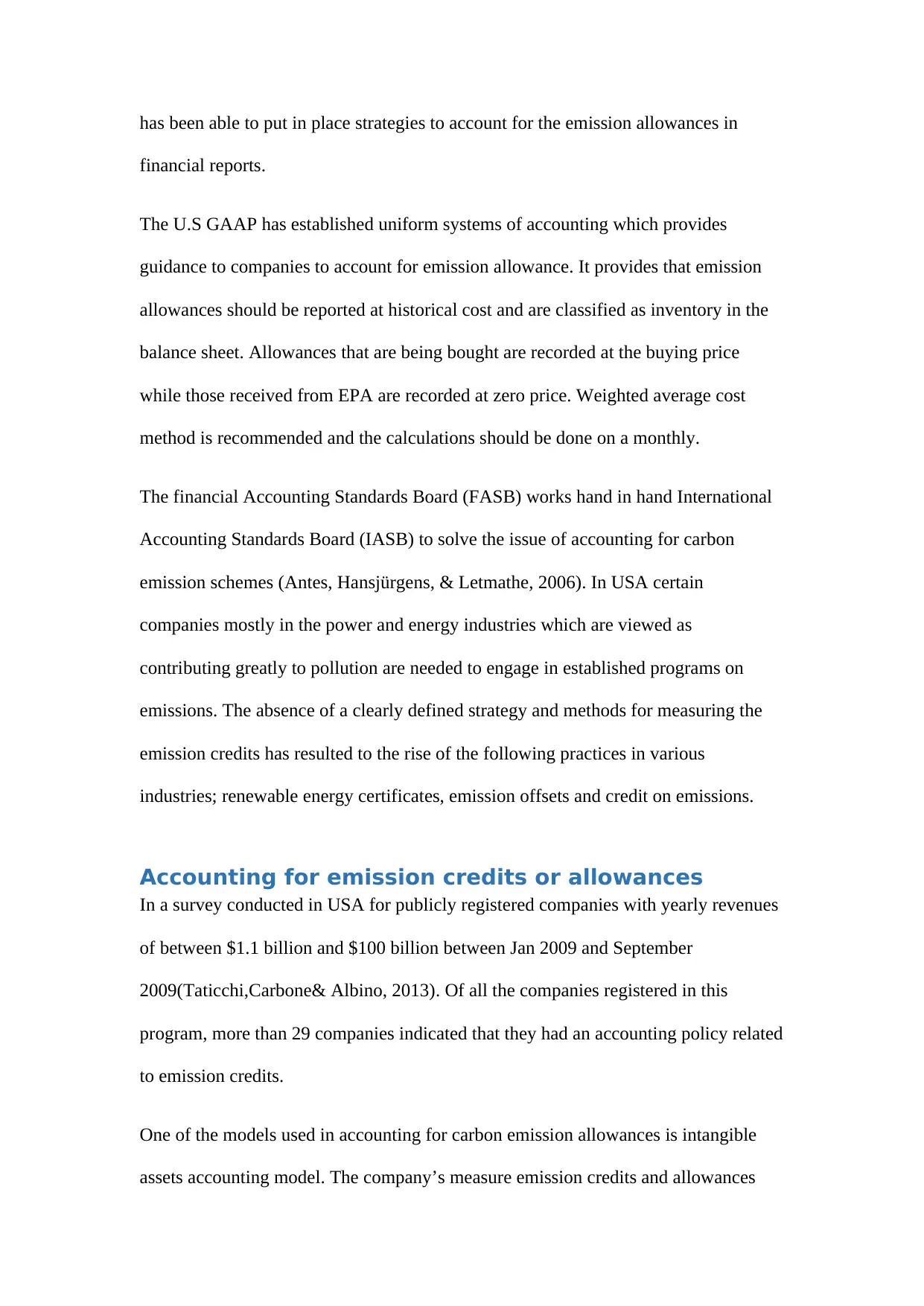
has been able to put in place strategies to account for the emission allowances in
financial reports.
The U.S GAAP has established uniform systems of accounting which provides
guidance to companies to account for emission allowance. It provides that emission
allowances should be reported at historical cost and are classified as inventory in the
balance sheet. Allowances that are being bought are recorded at the buying price
while those received from EPA are recorded at zero price. Weighted average cost
method is recommended and the calculations should be done on a monthly.
The financial Accounting Standards Board (FASB) works hand in hand International
Accounting Standards Board (IASB) to solve the issue of accounting for carbon
emission schemes (Antes, Hansjürgens, & Letmathe, 2006) . In USA certain
companies mostly in the power and energy industries which are viewed as
contributing greatly to pollution are needed to engage in established programs on
emissions. The absence of a clearly defined strategy and methods for measuring the
emission credits has resulted to the rise of the following practices in various
industries; renewable energy certificates, emission offsets and credit on emissions.
Accounting for emission credits or allowances
In a survey conducted in USA for publicly registered companies with yearly revenues
of between $1.1 billion and $100 billion between Jan 2009 and September
2009(Taticchi,Carbone& Albino, 2013). Of all the companies registered in this
program, more than 29 companies indicated that they had an accounting policy related
to emission credits.
One of the models used in accounting for carbon emission allowances is intangible
assets accounting model. The company’s measure emission credits and allowances
financial reports.
The U.S GAAP has established uniform systems of accounting which provides
guidance to companies to account for emission allowance. It provides that emission
allowances should be reported at historical cost and are classified as inventory in the
balance sheet. Allowances that are being bought are recorded at the buying price
while those received from EPA are recorded at zero price. Weighted average cost
method is recommended and the calculations should be done on a monthly.
The financial Accounting Standards Board (FASB) works hand in hand International
Accounting Standards Board (IASB) to solve the issue of accounting for carbon
emission schemes (Antes, Hansjürgens, & Letmathe, 2006) . In USA certain
companies mostly in the power and energy industries which are viewed as
contributing greatly to pollution are needed to engage in established programs on
emissions. The absence of a clearly defined strategy and methods for measuring the
emission credits has resulted to the rise of the following practices in various
industries; renewable energy certificates, emission offsets and credit on emissions.
Accounting for emission credits or allowances
In a survey conducted in USA for publicly registered companies with yearly revenues
of between $1.1 billion and $100 billion between Jan 2009 and September
2009(Taticchi,Carbone& Albino, 2013). Of all the companies registered in this
program, more than 29 companies indicated that they had an accounting policy related
to emission credits.
One of the models used in accounting for carbon emission allowances is intangible
assets accounting model. The company’s measure emission credits and allowances
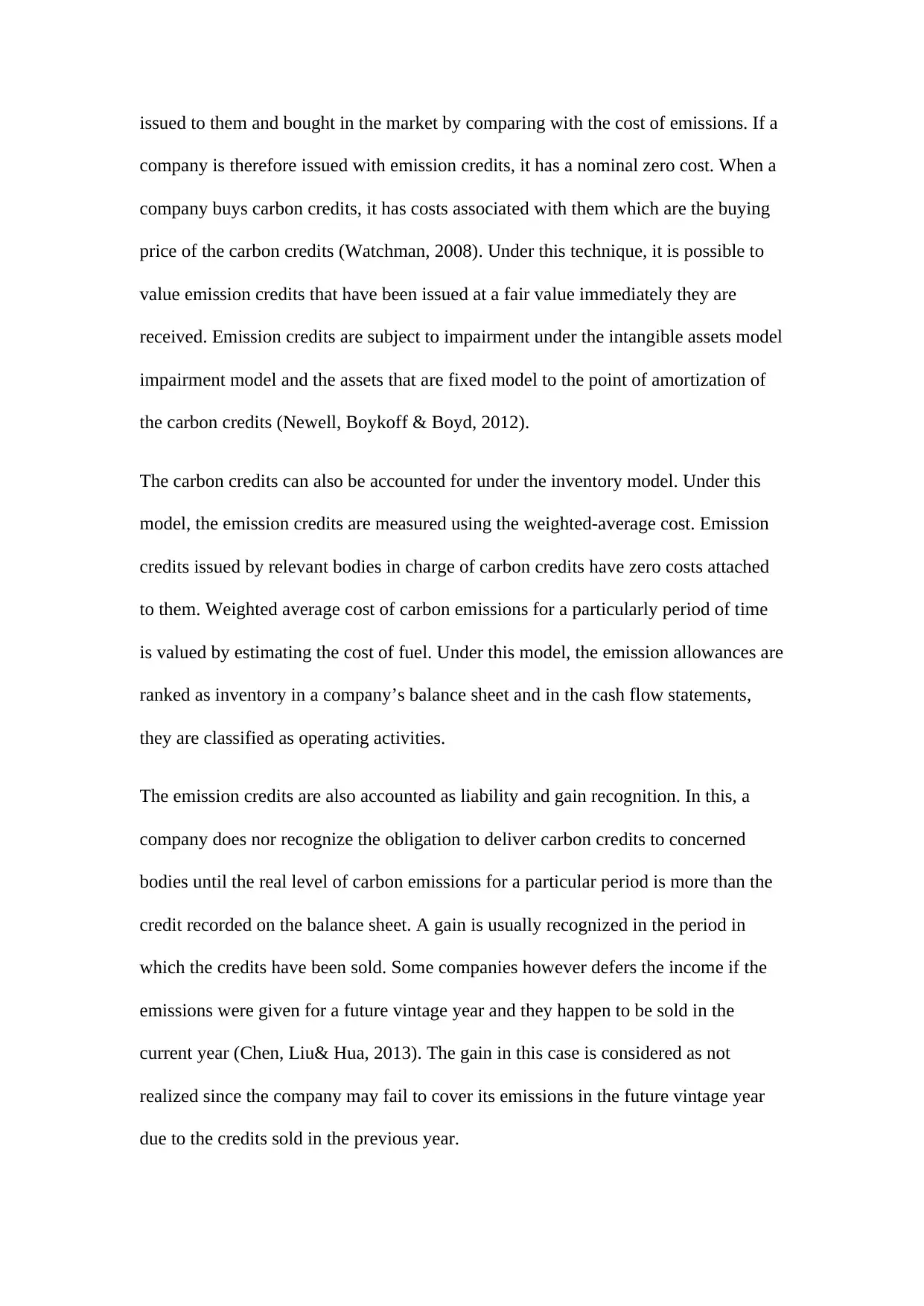
issued to them and bought in the market by comparing with the cost of emissions. If a
company is therefore issued with emission credits, it has a nominal zero cost. When a
company buys carbon credits, it has costs associated with them which are the buying
price of the carbon credits (Watchman, 2008). Under this technique, it is possible to
value emission credits that have been issued at a fair value immediately they are
received. Emission credits are subject to impairment under the intangible assets model
impairment model and the assets that are fixed model to the point of amortization of
the carbon credits (Newell, Boykoff & Boyd, 2012).
The carbon credits can also be accounted for under the inventory model. Under this
model, the emission credits are measured using the weighted-average cost. Emission
credits issued by relevant bodies in charge of carbon credits have zero costs attached
to them. Weighted average cost of carbon emissions for a particularly period of time
is valued by estimating the cost of fuel. Under this model, the emission allowances are
ranked as inventory in a company’s balance sheet and in the cash flow statements,
they are classified as operating activities.
The emission credits are also accounted as liability and gain recognition. In this, a
company does nor recognize the obligation to deliver carbon credits to concerned
bodies until the real level of carbon emissions for a particular period is more than the
credit recorded on the balance sheet. A gain is usually recognized in the period in
which the credits have been sold. Some companies however defers the income if the
emissions were given for a future vintage year and they happen to be sold in the
current year (Chen, Liu& Hua, 2013). The gain in this case is considered as not
realized since the company may fail to cover its emissions in the future vintage year
due to the credits sold in the previous year.
company is therefore issued with emission credits, it has a nominal zero cost. When a
company buys carbon credits, it has costs associated with them which are the buying
price of the carbon credits (Watchman, 2008). Under this technique, it is possible to
value emission credits that have been issued at a fair value immediately they are
received. Emission credits are subject to impairment under the intangible assets model
impairment model and the assets that are fixed model to the point of amortization of
the carbon credits (Newell, Boykoff & Boyd, 2012).
The carbon credits can also be accounted for under the inventory model. Under this
model, the emission credits are measured using the weighted-average cost. Emission
credits issued by relevant bodies in charge of carbon credits have zero costs attached
to them. Weighted average cost of carbon emissions for a particularly period of time
is valued by estimating the cost of fuel. Under this model, the emission allowances are
ranked as inventory in a company’s balance sheet and in the cash flow statements,
they are classified as operating activities.
The emission credits are also accounted as liability and gain recognition. In this, a
company does nor recognize the obligation to deliver carbon credits to concerned
bodies until the real level of carbon emissions for a particular period is more than the
credit recorded on the balance sheet. A gain is usually recognized in the period in
which the credits have been sold. Some companies however defers the income if the
emissions were given for a future vintage year and they happen to be sold in the
current year (Chen, Liu& Hua, 2013). The gain in this case is considered as not
realized since the company may fail to cover its emissions in the future vintage year
due to the credits sold in the previous year.
⊘ This is a preview!⊘
Do you want full access?
Subscribe today to unlock all pages.

Trusted by 1+ million students worldwide
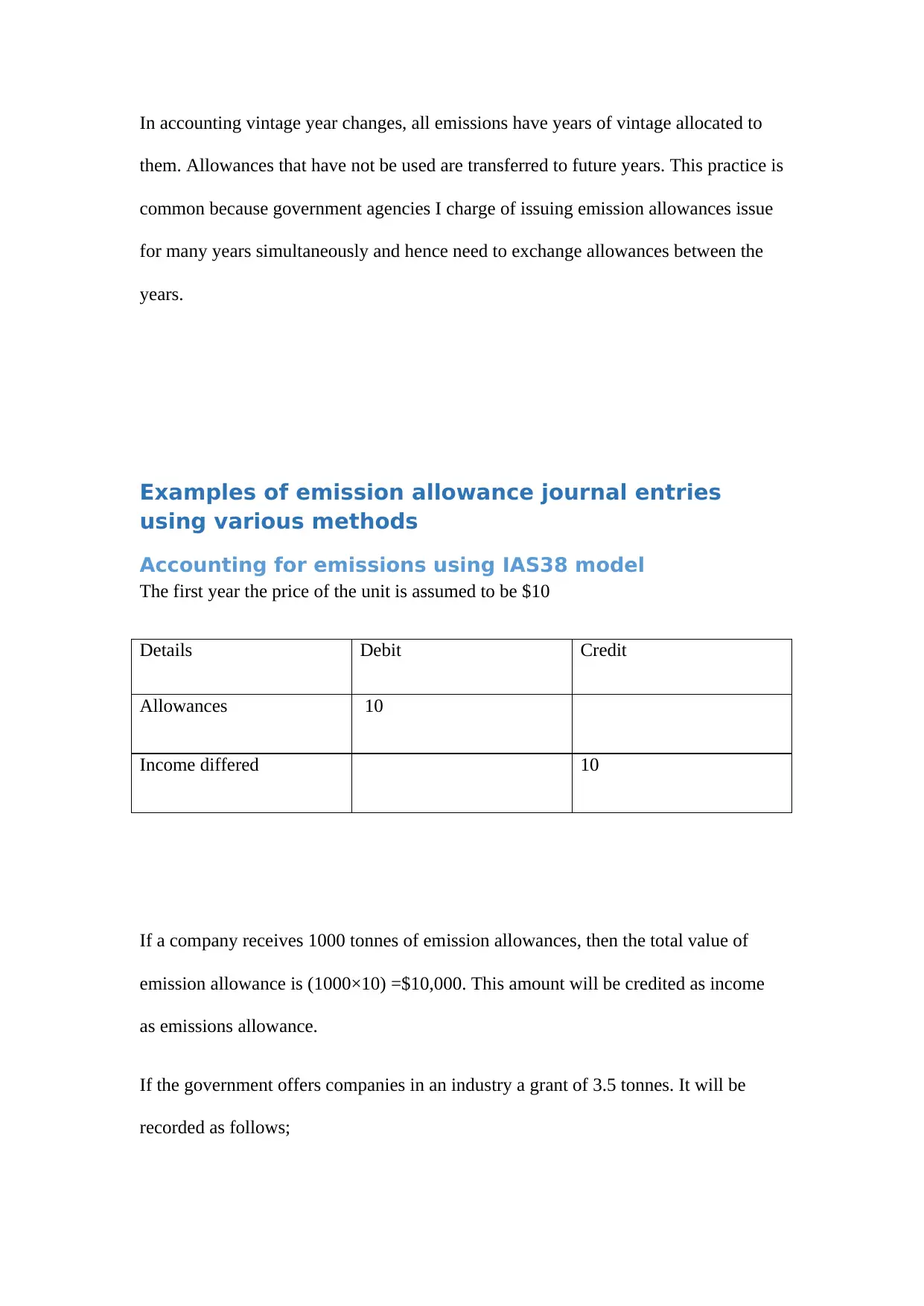
In accounting vintage year changes, all emissions have years of vintage allocated to
them. Allowances that have not be used are transferred to future years. This practice is
common because government agencies I charge of issuing emission allowances issue
for many years simultaneously and hence need to exchange allowances between the
years.
Examples of emission allowance journal entries
using various methods
Accounting for emissions using IAS38 model
The first year the price of the unit is assumed to be $10
Details Debit Credit
Allowances 10
Income differed 10
If a company receives 1000 tonnes of emission allowances, then the total value of
emission allowance is (1000×10) =$10,000. This amount will be credited as income
as emissions allowance.
If the government offers companies in an industry a grant of 3.5 tonnes. It will be
recorded as follows;
them. Allowances that have not be used are transferred to future years. This practice is
common because government agencies I charge of issuing emission allowances issue
for many years simultaneously and hence need to exchange allowances between the
years.
Examples of emission allowance journal entries
using various methods
Accounting for emissions using IAS38 model
The first year the price of the unit is assumed to be $10
Details Debit Credit
Allowances 10
Income differed 10
If a company receives 1000 tonnes of emission allowances, then the total value of
emission allowance is (1000×10) =$10,000. This amount will be credited as income
as emissions allowance.
If the government offers companies in an industry a grant of 3.5 tonnes. It will be
recorded as follows;
Paraphrase This Document
Need a fresh take? Get an instant paraphrase of this document with our AI Paraphraser
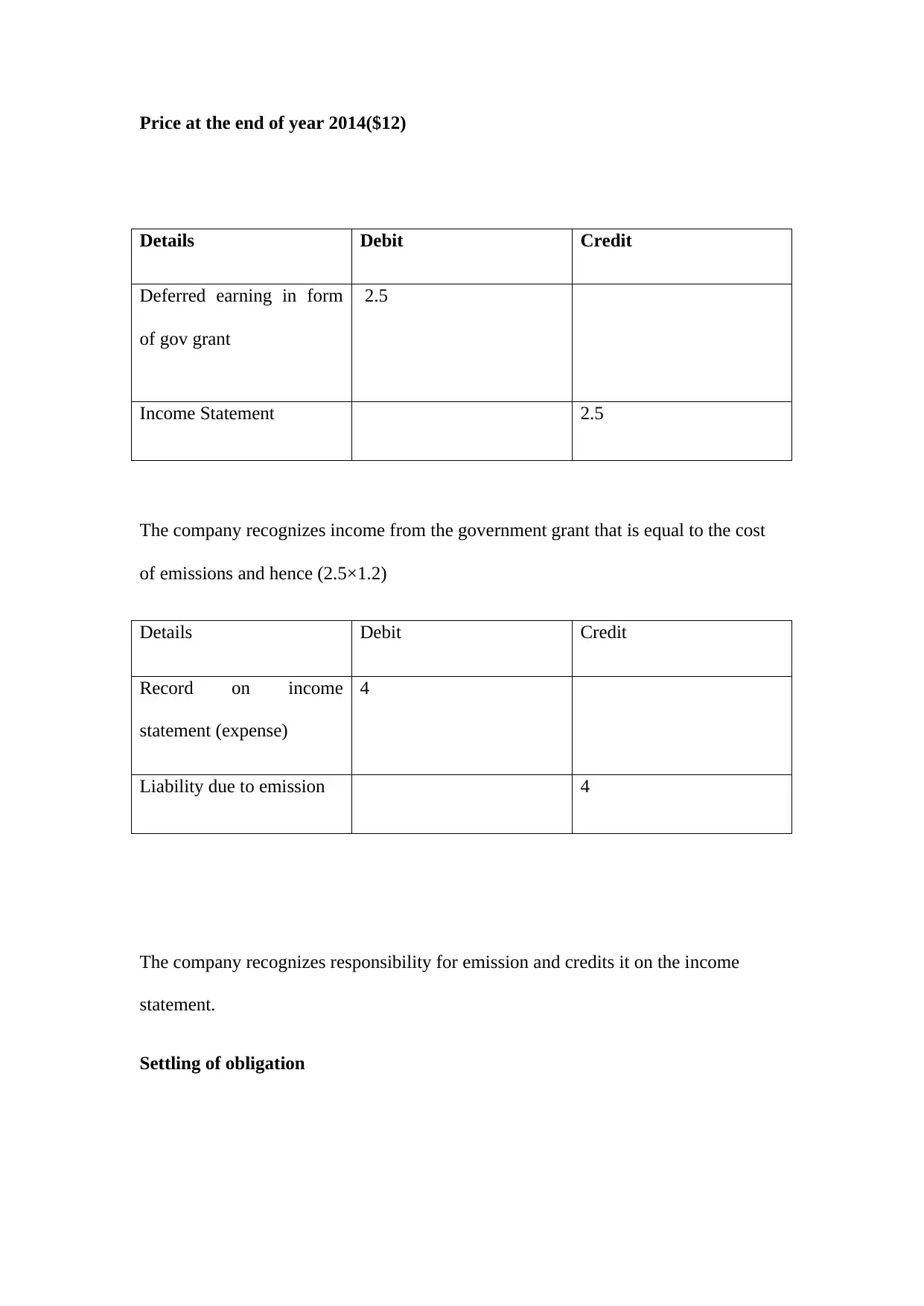
Price at the end of year 2014($12)
Details Debit Credit
Deferred earning in form
of gov grant
2.5
Income Statement 2.5
The company recognizes income from the government grant that is equal to the cost
of emissions and hence (2.5×1.2)
Details Debit Credit
Record on income
statement (expense)
4
Liability due to emission 4
The company recognizes responsibility for emission and credits it on the income
statement.
Settling of obligation
Details Debit Credit
Deferred earning in form
of gov grant
2.5
Income Statement 2.5
The company recognizes income from the government grant that is equal to the cost
of emissions and hence (2.5×1.2)
Details Debit Credit
Record on income
statement (expense)
4
Liability due to emission 4
The company recognizes responsibility for emission and credits it on the income
statement.
Settling of obligation
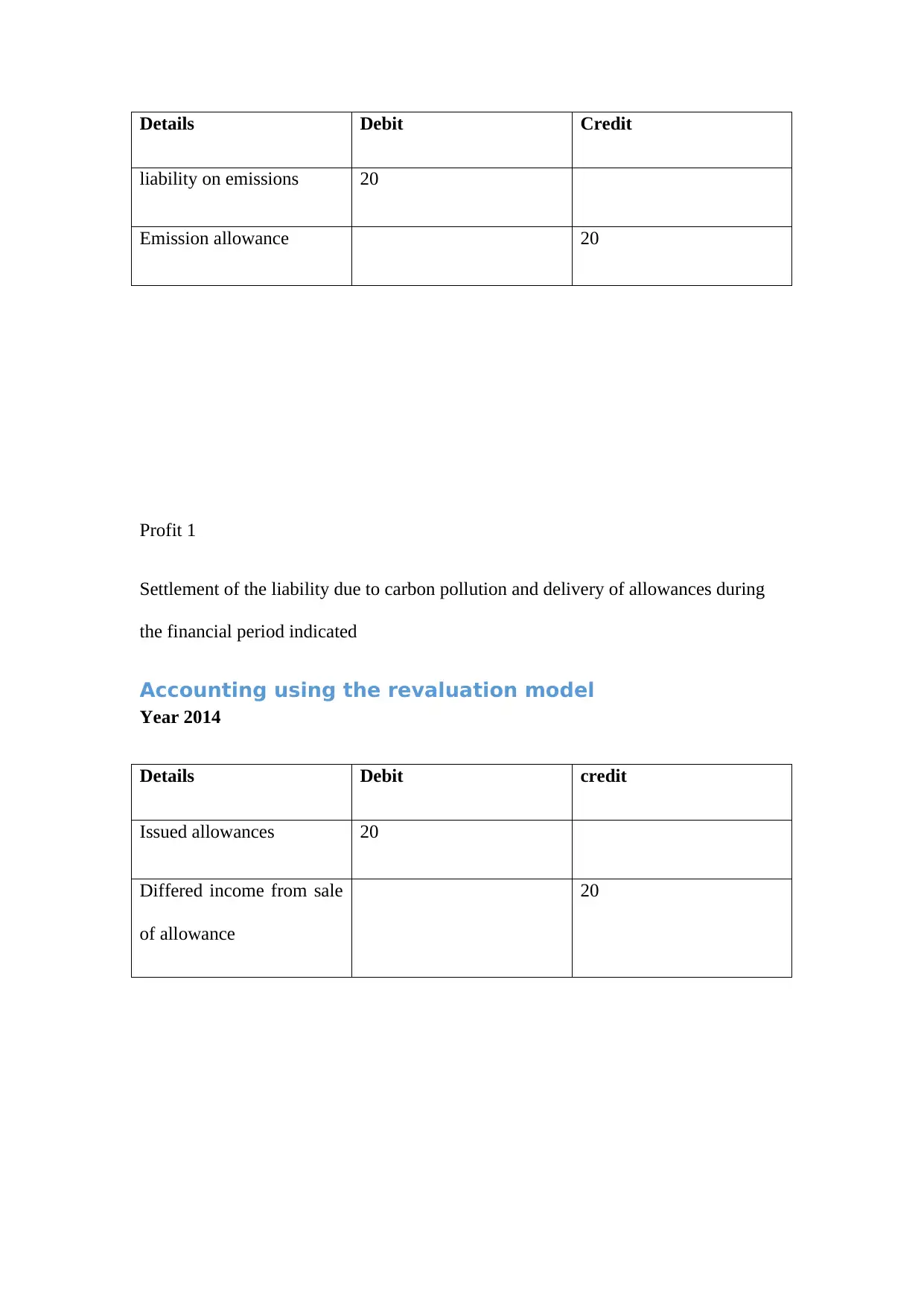
Details Debit Credit
liability on emissions 20
Emission allowance 20
Profit 1
Settlement of the liability due to carbon pollution and delivery of allowances during
the financial period indicated
Accounting using the revaluation model
Year 2014
Details Debit credit
Issued allowances 20
Differed income from sale
of allowance
20
liability on emissions 20
Emission allowance 20
Profit 1
Settlement of the liability due to carbon pollution and delivery of allowances during
the financial period indicated
Accounting using the revaluation model
Year 2014
Details Debit credit
Issued allowances 20
Differed income from sale
of allowance
20
⊘ This is a preview!⊘
Do you want full access?
Subscribe today to unlock all pages.

Trusted by 1+ million students worldwide
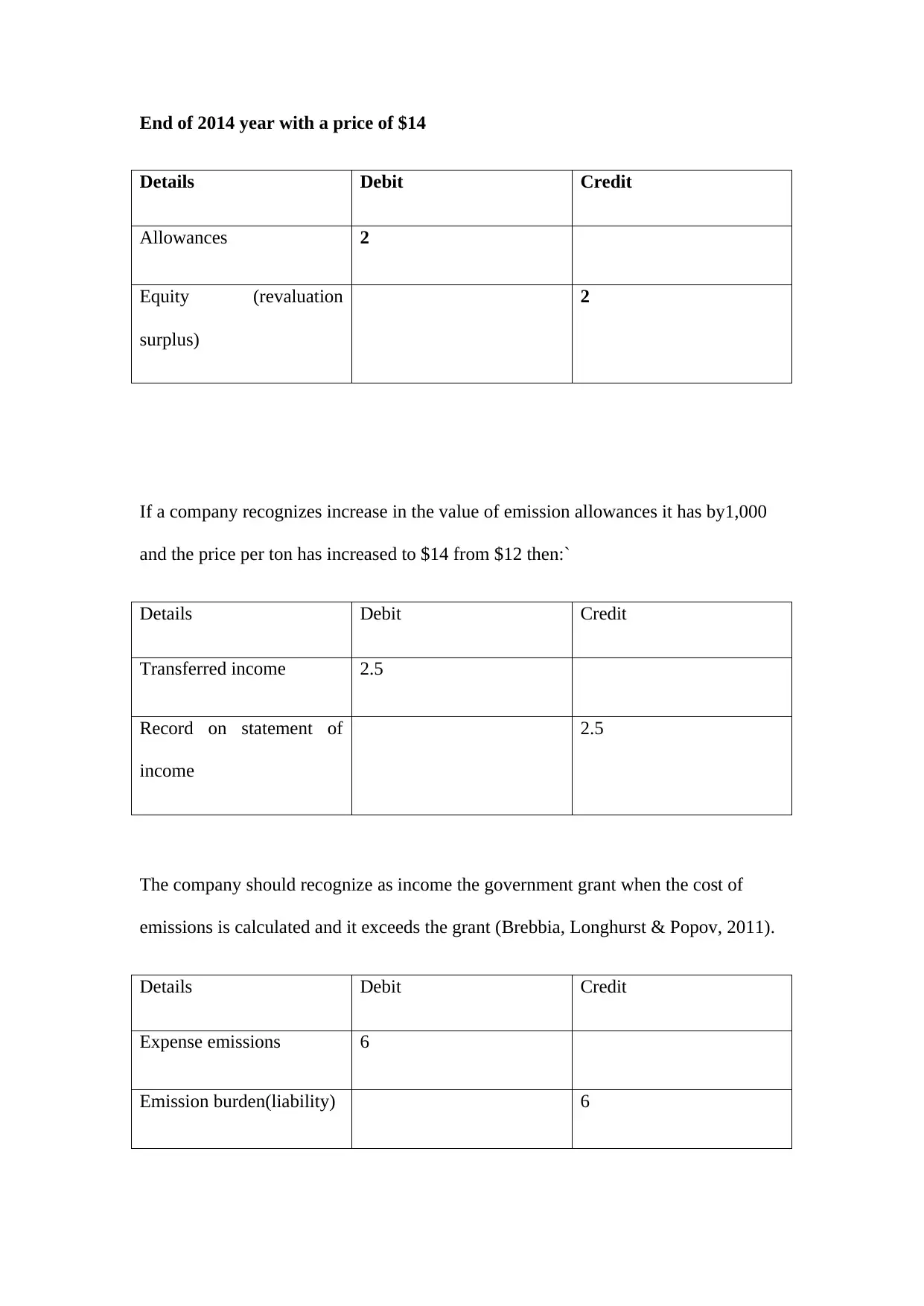
End of 2014 year with a price of $14
Details Debit Credit
Allowances 2
Equity (revaluation
surplus)
2
If a company recognizes increase in the value of emission allowances it has by1,000
and the price per ton has increased to $14 from $12 then:`
Details Debit Credit
Transferred income 2.5
Record on statement of
income
2.5
The company should recognize as income the government grant when the cost of
emissions is calculated and it exceeds the grant (Brebbia, Longhurst & Popov, 2011).
Details Debit Credit
Expense emissions 6
Emission burden(liability) 6
Details Debit Credit
Allowances 2
Equity (revaluation
surplus)
2
If a company recognizes increase in the value of emission allowances it has by1,000
and the price per ton has increased to $14 from $12 then:`
Details Debit Credit
Transferred income 2.5
Record on statement of
income
2.5
The company should recognize as income the government grant when the cost of
emissions is calculated and it exceeds the grant (Brebbia, Longhurst & Popov, 2011).
Details Debit Credit
Expense emissions 6
Emission burden(liability) 6
Paraphrase This Document
Need a fresh take? Get an instant paraphrase of this document with our AI Paraphraser
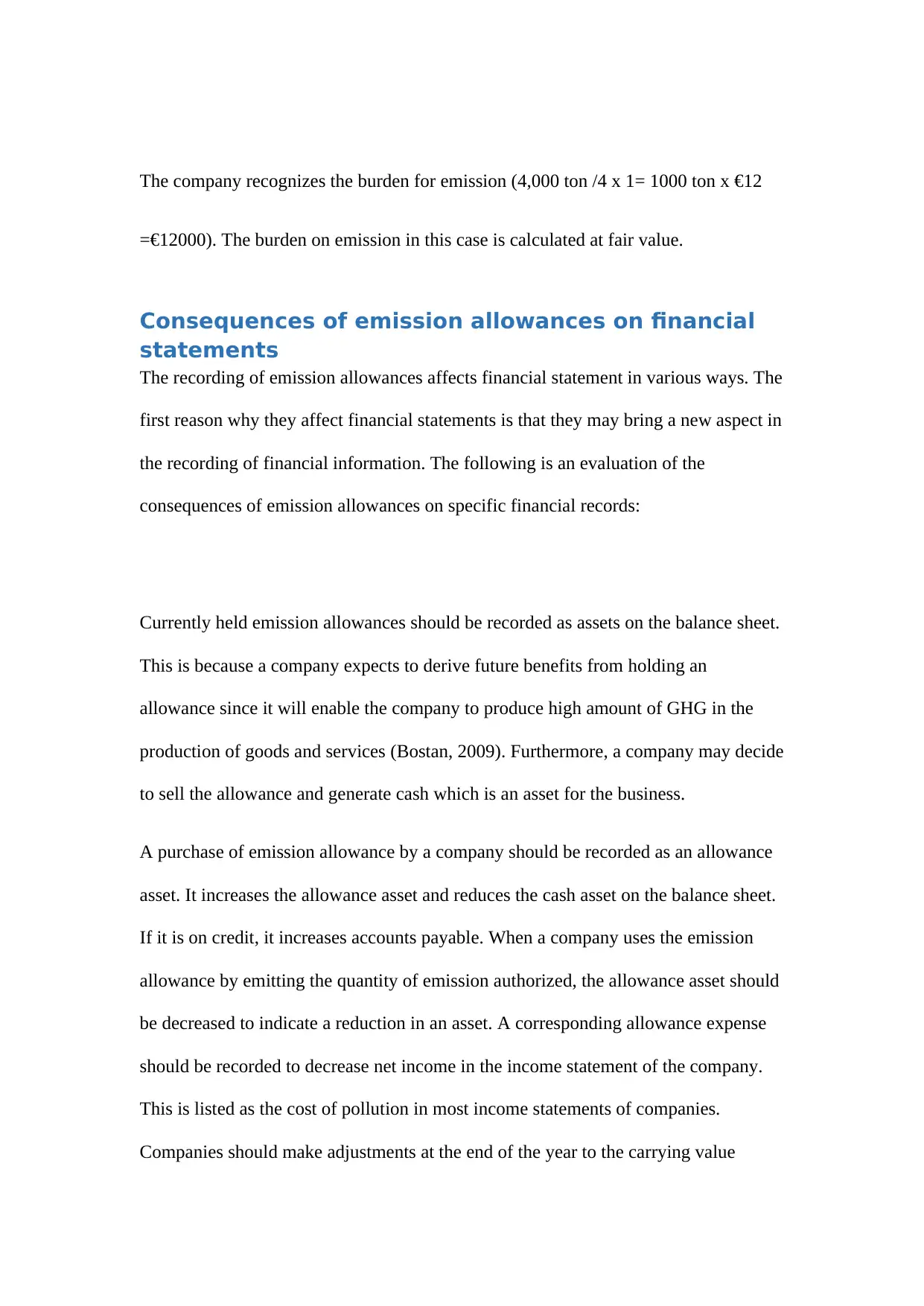
The company recognizes the burden for emission (4,000 ton /4 x 1= 1000 ton x €12
=€12000). The burden on emission in this case is calculated at fair value.
Consequences of emission allowances on financial
statements
The recording of emission allowances affects financial statement in various ways. The
first reason why they affect financial statements is that they may bring a new aspect in
the recording of financial information. The following is an evaluation of the
consequences of emission allowances on specific financial records:
Currently held emission allowances should be recorded as assets on the balance sheet.
This is because a company expects to derive future benefits from holding an
allowance since it will enable the company to produce high amount of GHG in the
production of goods and services (Bostan, 2009). Furthermore, a company may decide
to sell the allowance and generate cash which is an asset for the business.
A purchase of emission allowance by a company should be recorded as an allowance
asset. It increases the allowance asset and reduces the cash asset on the balance sheet.
If it is on credit, it increases accounts payable. When a company uses the emission
allowance by emitting the quantity of emission authorized, the allowance asset should
be decreased to indicate a reduction in an asset. A corresponding allowance expense
should be recorded to decrease net income in the income statement of the company.
This is listed as the cost of pollution in most income statements of companies.
Companies should make adjustments at the end of the year to the carrying value
=€12000). The burden on emission in this case is calculated at fair value.
Consequences of emission allowances on financial
statements
The recording of emission allowances affects financial statement in various ways. The
first reason why they affect financial statements is that they may bring a new aspect in
the recording of financial information. The following is an evaluation of the
consequences of emission allowances on specific financial records:
Currently held emission allowances should be recorded as assets on the balance sheet.
This is because a company expects to derive future benefits from holding an
allowance since it will enable the company to produce high amount of GHG in the
production of goods and services (Bostan, 2009). Furthermore, a company may decide
to sell the allowance and generate cash which is an asset for the business.
A purchase of emission allowance by a company should be recorded as an allowance
asset. It increases the allowance asset and reduces the cash asset on the balance sheet.
If it is on credit, it increases accounts payable. When a company uses the emission
allowance by emitting the quantity of emission authorized, the allowance asset should
be decreased to indicate a reduction in an asset. A corresponding allowance expense
should be recorded to decrease net income in the income statement of the company.
This is listed as the cost of pollution in most income statements of companies.
Companies should make adjustments at the end of the year to the carrying value
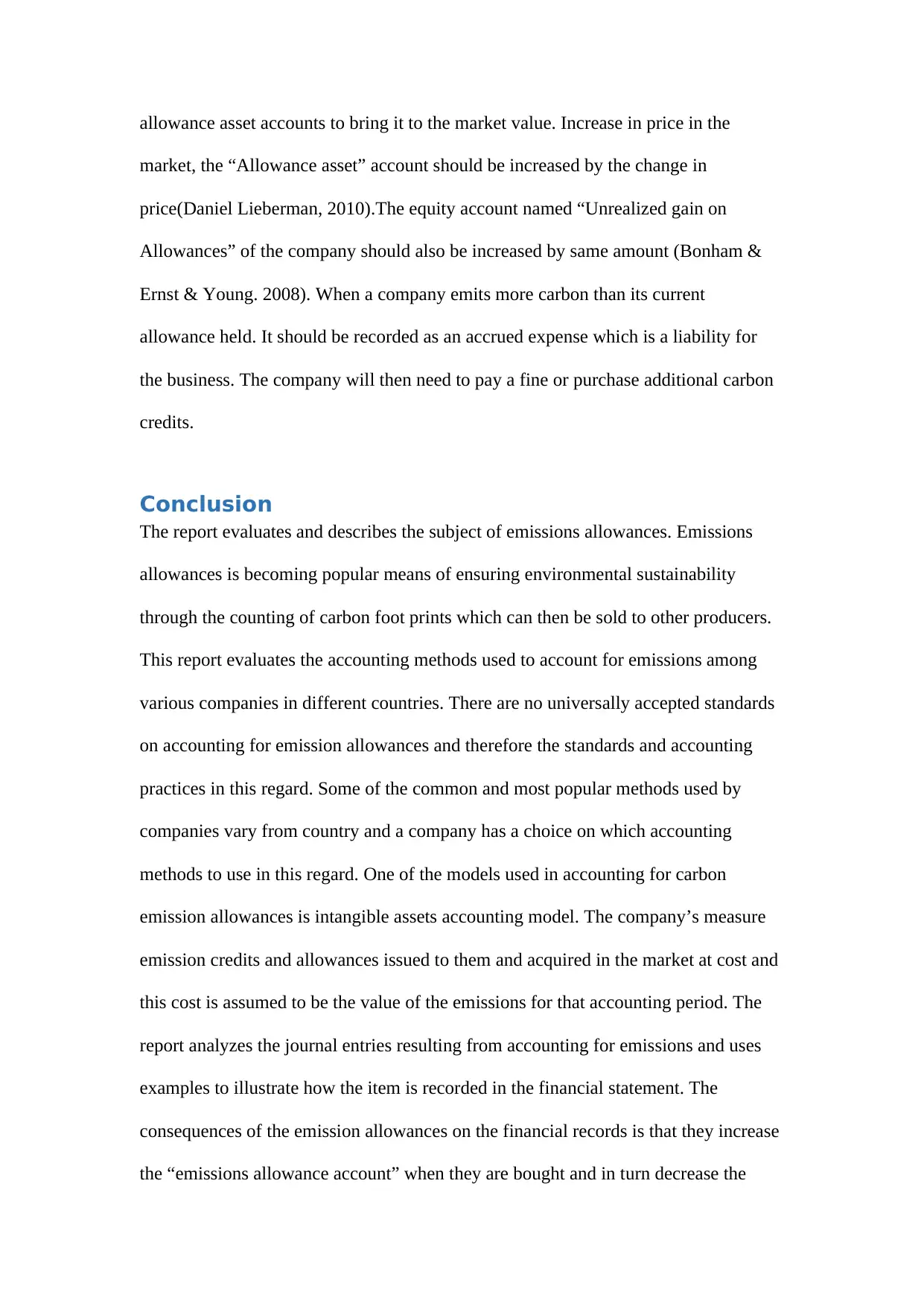
allowance asset accounts to bring it to the market value. Increase in price in the
market, the “Allowance asset” account should be increased by the change in
price(Daniel Lieberman, 2010).The equity account named “Unrealized gain on
Allowances” of the company should also be increased by same amount (Bonham &
Ernst & Young. 2008). When a company emits more carbon than its current
allowance held. It should be recorded as an accrued expense which is a liability for
the business. The company will then need to pay a fine or purchase additional carbon
credits.
Conclusion
The report evaluates and describes the subject of emissions allowances. Emissions
allowances is becoming popular means of ensuring environmental sustainability
through the counting of carbon foot prints which can then be sold to other producers.
This report evaluates the accounting methods used to account for emissions among
various companies in different countries. There are no universally accepted standards
on accounting for emission allowances and therefore the standards and accounting
practices in this regard. Some of the common and most popular methods used by
companies vary from country and a company has a choice on which accounting
methods to use in this regard. One of the models used in accounting for carbon
emission allowances is intangible assets accounting model. The company’s measure
emission credits and allowances issued to them and acquired in the market at cost and
this cost is assumed to be the value of the emissions for that accounting period. The
report analyzes the journal entries resulting from accounting for emissions and uses
examples to illustrate how the item is recorded in the financial statement. The
consequences of the emission allowances on the financial records is that they increase
the “emissions allowance account” when they are bought and in turn decrease the
market, the “Allowance asset” account should be increased by the change in
price(Daniel Lieberman, 2010).The equity account named “Unrealized gain on
Allowances” of the company should also be increased by same amount (Bonham &
Ernst & Young. 2008). When a company emits more carbon than its current
allowance held. It should be recorded as an accrued expense which is a liability for
the business. The company will then need to pay a fine or purchase additional carbon
credits.
Conclusion
The report evaluates and describes the subject of emissions allowances. Emissions
allowances is becoming popular means of ensuring environmental sustainability
through the counting of carbon foot prints which can then be sold to other producers.
This report evaluates the accounting methods used to account for emissions among
various companies in different countries. There are no universally accepted standards
on accounting for emission allowances and therefore the standards and accounting
practices in this regard. Some of the common and most popular methods used by
companies vary from country and a company has a choice on which accounting
methods to use in this regard. One of the models used in accounting for carbon
emission allowances is intangible assets accounting model. The company’s measure
emission credits and allowances issued to them and acquired in the market at cost and
this cost is assumed to be the value of the emissions for that accounting period. The
report analyzes the journal entries resulting from accounting for emissions and uses
examples to illustrate how the item is recorded in the financial statement. The
consequences of the emission allowances on the financial records is that they increase
the “emissions allowance account” when they are bought and in turn decrease the
⊘ This is a preview!⊘
Do you want full access?
Subscribe today to unlock all pages.

Trusted by 1+ million students worldwide
1 out of 15
Related Documents
Your All-in-One AI-Powered Toolkit for Academic Success.
+13062052269
info@desklib.com
Available 24*7 on WhatsApp / Email
![[object Object]](/_next/static/media/star-bottom.7253800d.svg)
Unlock your academic potential
Copyright © 2020–2025 A2Z Services. All Rights Reserved. Developed and managed by ZUCOL.





